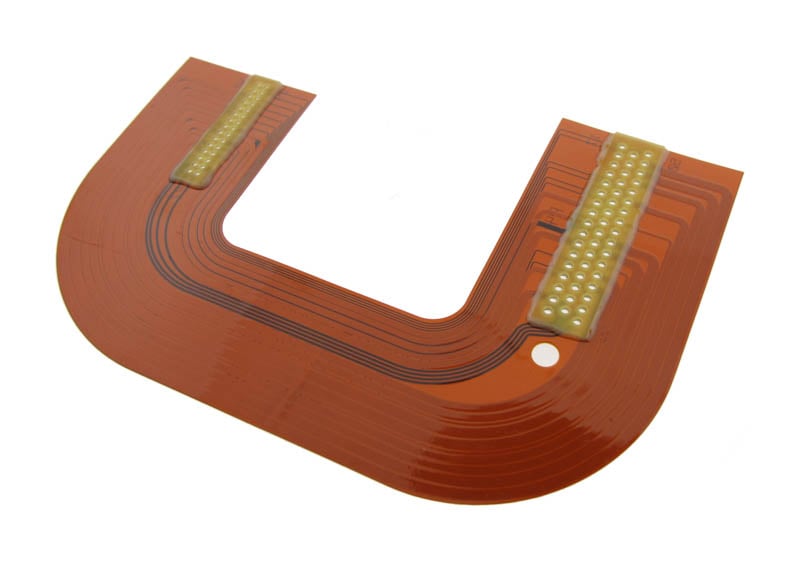HEAVY COPPER IN FPC
Creating a high-performance flexible printed circuit board is contingent upon having the right copper weight. With high-temperature, high-power, and long-lasting applications, the weight of the copper used becomes even more important.
In flexible PCBs, copper weight is a critical factor that influences both the electrical performance and the mechanical characteristics of the circuit. Understanding how copper weight impacts the functionality of a flexible printed circuit board, the impacts that weight has on flexibility, design considerations, and drawbacks of heavier copper weights is critical for anyone developing a new high-performance flexible PCB.
Introduction
With modern flexible printed circuit boards, a copper weight of 2 oz per square foot (oz/ft²) or higher is considered “heavy copper”. Typical rigid PCBs have a copper weight of around 1 oz/ft². Thicker copper layers can enhance the current-carrying capabilities of a circuit, but they also come with significant challenges when it comes to manufacturability, flexibility, and overall cost.
Impact Of Heavy Copper
Perhaps the biggest impact of heavy copper usage within a flexible PCB is the impact on the board’s overall flexibility. Higher copper weights come with less flexibility since the copper itself is too thick to bend easily. The added rigidity also comes from the added adhesives used for lamination and coverlay (insulative layers).

Example of a flexible printed circuit board with heavy copper weights.
Reductions in flexibility might hurt the functionality of a flexible PCB, so there is often an effort to balance flexibility and capability to carry a current.
One option is splitting the copper weight across multiple layers instead of concentrating the entire weight in a single layer. Doing this can help the overall performance while still helping with manufacturability and cost reduction.
Line Widths And Spacing
Heavy copper weights also influence the minimum line widths and spacing in the circuit design. Intuitively, thicker runs of copper require wider lines in the flexible PCB to fit the wire, plus additional space to allow for manufacturing.
This growth in line widths and spacing can limit the circuit's density, making it challenging to achieve high-density interconnects (HDI) in designs that also require heavy copper.
When working with copper weights of 3 oz. and above, consider using additional processes such as plating or laminating copper sheets together.
For instance, a 3-oz. copper weight typically requires plating from 2 oz. copper up to 3 oz., or special ordering of material if the quantities are large enough. Beyond 3 oz., manufacturers may need to laminate copper sheets together, which further complicates the manufacturing process and increases costs.
Drawbacks
Using heavy copper in flexible printed circuit boards comes with some noteworthy drawbacks. The increased copper weight leads to higher material costs and more complex manufacturing processes.
In addition, the reduced flexibility and the necessity for specialized manufacturing techniques can limit the number of manufacturers capable of producing heavy copper flexible printed circuit boards. This can make it hard to find a high-quality manufacturer to help build your circuit boards.
Another challenge is the availability of coverlay materials. As copper weights increase, standard coverlay materials may no longer be suitable. Instead, designers will need to rely on flexible liquid photo imageable (LPI) solder masks instead. This limitation can affect the overall design and durability of the flexible PCB.
The use of heavy copper can also result in longer lead times, especially for specialty copper weights that may not be readily available. This extended lead time can impact project timelines, making it essential for designers to plan accordingly.
Finally, the reduced flexibility associated with heavy copper can limit the number of layers in a flexible PCB design. This limitation is particularly important in complex circuits where multiple layers are required to achieve the desired functionality.
Why Use it?
Heavy copper weights are indispensable in certain applications. Heavier copper has superior current-carrying capacity and thermal conductivity. These properties make heavy copper flexible PCBs ideal for power electronics, military applications, certain medical devices, automation systems, and electric vehicles.
In power applications, the need to handle high current loads without significant voltage drops or overheating is critical. Heavy copper provides the necessary cross-sectional area to carry large currents efficiently while minimizing the overall heat that’s generated.
In applications where thermal management is a concern, like power supplies or motor drives, the enhanced thermal conductivity of heavy copper can help dissipate heat more effectively. This can significantly improve the reliability and lifespan of the circuit.
Best Practices For Implementing
When designing with heavy copper, it’s crucial to consider both the electrical and mechanical requirements of the application. As previously mentioned, splitting the copper weight across multiple layers can help balance performance with manufacturability. Working closely with manufacturers to choose the perfect copper weight can also help. They can help strike a balance between cost, functionality, and turnaround times.
In applications where flexibility is critical, designers should evaluate whether heavy copper is necessary for all areas of the circuit or if it can be localized to specific regions. This approach can maintain flexibility where needed while still benefiting from the enhanced current-carrying capacity of heavy copper.
Summary
Heavy copper weights play a vital role in the performance of flexible printed circuit boards, particularly in applications requiring high current-carrying capacity and thermal management. However, their use comes with significant challenges, including reduced flexibility, increased manufacturing complexity, and higher costs.
By understanding these factors and using best practices in design and manufacturing, engineers can effectively leverage heavy copper in their flexible PCB designs, ensuring that the final product meets both electrical and mechanical requirements. Our team of experienced engineers is here to help you design and manufacture high-quality flexible printed circuit boards that will meet your functional needs.
Capabilities
Payment Methods
Specials Price
Carriers
Support Hobbyist
Certificate
Customer Support
Follow Us
Tel: 1-905-339-2881
Email: sales@goldphoenixpcb.com , tech@goldphoenixpcb.com
Copyright Gold Phoenix PCB Co., Ltd. 2011 - 2025
Tel: 1-905-339-2881 Email: sales@goldphoenixpcb.com , tech@goldphoenixpcb.com
Quality Control System
|
Products/Service
|
Friendly Links
Copyright Gold Phoenix PCB Co., Ltd. 2011 - 2025


